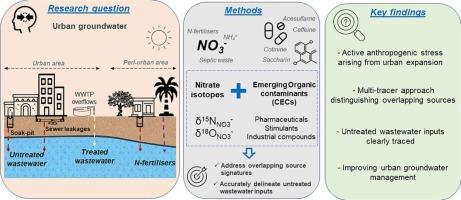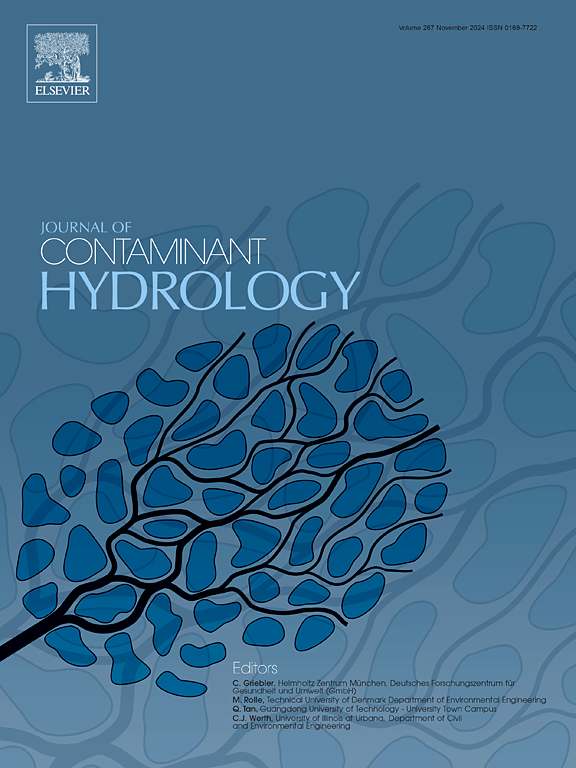整合硝酸盐同位素和新关注的有机污染物以改善城市地下水中未处理废水的追踪
IF 4.4
3区 环境科学与生态学
Q2 ENVIRONMENTAL SCIENCES
引用次数: 0
摘要
在卫生战略不足的城市环境中,未经处理的废水是地下水污染的主要来源。确定这种污染的来源和地下途径对于有效的地下水管理至关重要,但在受多种人为输入影响的环境中,这仍然具有挑战性。虽然硝酸盐同位素(δ15N-NO3−,δ18O-NO3−)通常用于追踪污染源,但它们在区分重叠同位素特征方面有自己的局限性,包括废水和粪便,或未经处理和处理的废水的混合物。采用结合水文地球化学、同位素和有机工具的多示踪方法,准确描绘了城市/近郊混合环境中废水的影响。城市环境中硝酸盐浓度的增加归因于人口增长和广泛使用简陋的现场卫生系统(浸水坑)所造成的积极的人为压力。硝酸盐同位素初步证实化粪池废物是主要污染源,但无法区分未经处理的污水输入。在城市周边环境中,在异质住宅景观中,家庭和农业影响的潜在相互作用进一步使污染过程的解释复杂化。安赛蜜是一种几乎理想的废水共示踪剂,其浓度与不稳定和普遍存在的标记物(糖精、可替宁)的浓度之间存在很强的相关性,表明近期未经处理的废水受到了广泛的污染。非无处不在的药品的出现证实了现场卫生系统的准时影响。在城郊地区零星检测到安赛蜜,突显出这些地区容易受到人为影响。硝酸盐同位素和有机污染物的互补性大大提高了我们准确识别未经处理的废水输入来源和时间的能力。本文章由计算机程序翻译,如有差异,请以英文原文为准。

Integrating nitrate isotopes and organic contaminants of emerging concern to improve untreated wastewater tracing in urban groundwater
Untreated wastewater represents a major source of groundwater contamination in urban contexts with inadequate sanitation strategies. Identifying the origins and subsurface pathways of this contamination is essential for effective groundwater management, yet it remains challenging in environments influenced by multiple anthropogenic inputs. Although nitrate isotopes (δ15N-NO3−, δ18O-NO3−) are commonly used to trace contamination sources, they have their own limitations for distinguishing overlapping isotopic signatures, including those of wastewater and manure, or a mixture of untreated and treated wastewater inputs. A multi-tracer approach combining hydrogeochemical, isotopic and organic tools were used to accurately delineate wastewater impacts in mixed urban/peri-urban environments. Increasing nitrate concentrations in urban environments were attributed to an active anthropogenic stress, arising from population growth and widespread use of rudimentary on-site sanitation systems (soak-pits). Nitrate isotopes preliminarily confirmed that septic waste as the main source of pollution, but were unable to differentiate untreated wastewater inputs. In peri-urban settings, the potential interaction of domestic and agricultural influences in a heterogeneous residential landscape further complicated the interpretation of contamination processes. A strong correlation of acesulfame concentrations, a nearly ideal wastewater co-tracer, with those of labile and ubiquitous markers (saccharin, cotinine) indicated widespread contamination by recent untreated wastewater. The occurrence of non-ubiquitous pharmaceuticals confirmed the punctual impact of on-site sanitation systems. The sporadic detection of acesulfame in peri-urban areas underlines their vulnerability to man-made influences. The complementarity of nitrate isotopes and organic contaminants has significantly improved our ability to accurately identify the sources and timing of untreated wastewater inputs.
求助全文
通过发布文献求助,成功后即可免费获取论文全文。
去求助
来源期刊

Journal of contaminant hydrology
环境科学-地球科学综合
CiteScore
6.80
自引率
2.80%
发文量
129
审稿时长
68 days
期刊介绍:
The Journal of Contaminant Hydrology is an international journal publishing scientific articles pertaining to the contamination of subsurface water resources. Emphasis is placed on investigations of the physical, chemical, and biological processes influencing the behavior and fate of organic and inorganic contaminants in the unsaturated (vadose) and saturated (groundwater) zones, as well as at groundwater-surface water interfaces. The ecological impacts of contaminants transported both from and to aquifers are of interest. Articles on contamination of surface water only, without a link to groundwater, are out of the scope. Broad latitude is allowed in identifying contaminants of interest, and include legacy and emerging pollutants, nutrients, nanoparticles, pathogenic microorganisms (e.g., bacteria, viruses, protozoa), microplastics, and various constituents associated with energy production (e.g., methane, carbon dioxide, hydrogen sulfide).
The journal''s scope embraces a wide range of topics including: experimental investigations of contaminant sorption, diffusion, transformation, volatilization and transport in the surface and subsurface; characterization of soil and aquifer properties only as they influence contaminant behavior; development and testing of mathematical models of contaminant behaviour; innovative techniques for restoration of contaminated sites; development of new tools or techniques for monitoring the extent of soil and groundwater contamination; transformation of contaminants in the hyporheic zone; effects of contaminants traversing the hyporheic zone on surface water and groundwater ecosystems; subsurface carbon sequestration and/or turnover; and migration of fluids associated with energy production into groundwater.
 求助内容:
求助内容: 应助结果提醒方式:
应助结果提醒方式:


